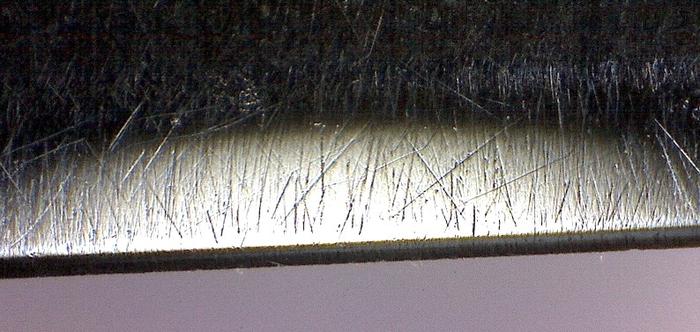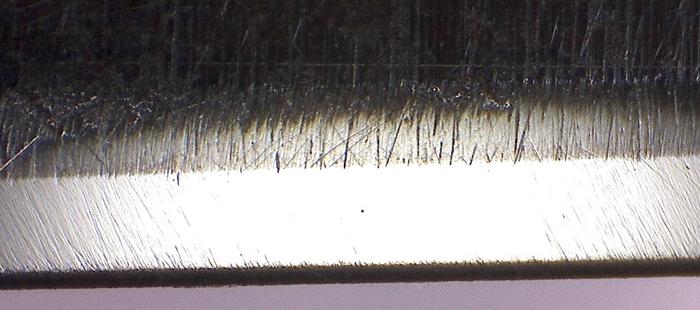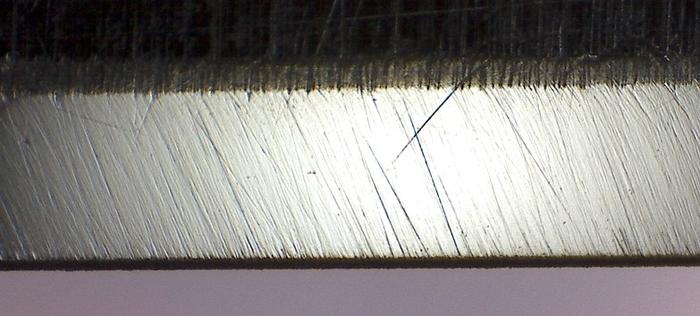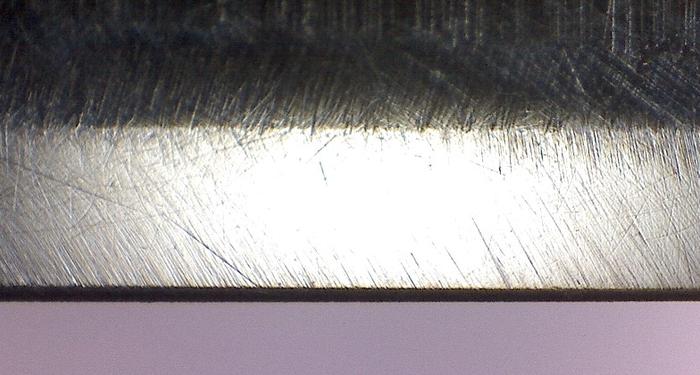Results 1 to 10 of 13
Thread: Tripple bevel
Threaded View
-
06-21-2013, 10:57 AM #1Senior Member

- Join Date
- May 2013
- Location
- Berlin, Germany
- Posts
- 286
Thanked: 39 Tripple bevel
Tripple bevel
This is an interesting experiment and a visual demonstration for the non-believers.
Every now and then someone is honing a razor with a 5k or even higher grit stone and wondering why the thing is not getting sharp. He then will be told that the most likely the bevel has not been set properly and that it is almost to impossible to accomplish that with a high grit stone.
Yesterday I had a look at the edge of my Friedrich Schrick, that I recently got from ebay. The edge was dull but undamaged and I found that it had a "nice" double bevel on one side.
The very edge had been honed with a greater angle. Very nice to see under the loupe and when watching the reflections. When turning the blade under light, the reflection "switches".
Under the microscope it looks like that:

There are hone-marks on the spine. So it had been honed without taping, at least some time in history. I use tape, especially here, as I need a steeper angle to get down to the very edge. If the last honing had been done without tape, the old (upper) edge would be less steep than my new scratches.
And so it was. In order to see where I was, I taped the spine, did some 20, 30 strokes on a 5k stone and got the expected result:

From bottom up: the very steep edge, followed by my taped strokes and the not taped strokes. We've now got three bevels.
As we're cutting with the edge, this is our primary target. However, I can't get there, as my bevel is in the way. The third bevel is of no interest, as it is less steep and I am already able to overcome it with my 5k strokes.
Seeing how much I achieved with just a few strokes on a 5k stone might lead to the conclusion, that the tiny rest could be done easily as well. We're talking about something like 220 power and the width of the lower bevel is around 0.04mm (0.00 inches shown ). Should be an easy job, shouldn't it? The answer is NO!
). Should be an easy job, shouldn't it? The answer is NO!
Going down to the bevel setter is the only way, but as I had this nice demo-situation at hand and felt like playing, I first did something like a 100 strokes on the 5k and some circles. The effect was close to nothing.
I then went down to a 3k stone and did about 200 circles and several hundred x-strokes. The outcome after about an hour of work was this:


As You see, the new bevel is mainly crawling up towards the upper (and less steep) bevel and close to nothing down to the edge. After more than an hour of honing on the 3k stone, I did not touch the edge once.
The lower bevel now is a bit smaller, but still there. It can hardly be seen with a loupe. Reflection still works to detect it, but You need to know what You're looking for.
It would now probably take another 1000 x-strokes or more to get down to the edge. Until that is not reached, the razor's sharpness is not affected at all.
In this case the razor already had the second bevel. However, the effect is the same when You get a razor honed with unknown ( but steeper ) angle.Last edited by DDTech; 06-21-2013 at 11:00 AM.
-
The Following 3 Users Say Thank You to DDTech For This Useful Post:
Geezer (06-22-2013), Mvcrash (06-21-2013), Rockabillyhelge (06-21-2013)


 6Likes
6Likes LinkBack URL
LinkBack URL About LinkBacks
About LinkBacks






 Reply With Quote
Reply With Quote
